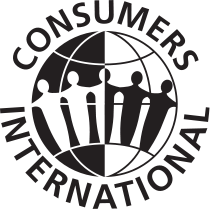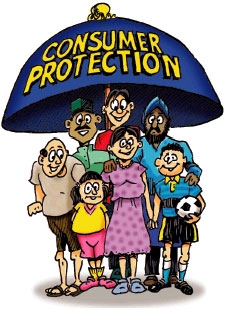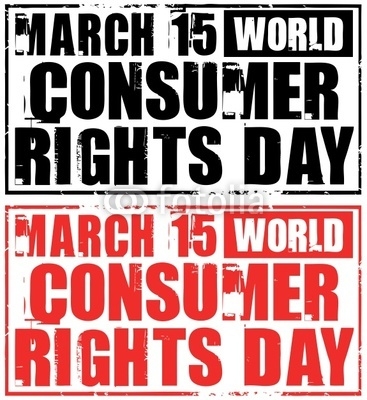World Consumer Rights Day 2025 is on Saturday, March 15, 2025: please tell me about consumer rights and privelages?
Saturday, March 15, 2025 is World Consumer Rights Day 2025. Consumers International (CI) is the world federation of consumer groups that serves as the only independent and authoritative global voice for consumers.

Consumers International (CI) is the world federation of consumer groups that serves as the only independent and authoritative global voice for consumers.

CONSUMER RIGHTS AND PRIVELAGES
I. Introduction
Consumer rights are now an integral part of our lives like a consumerist way of life. They have been well documented and much talked about. We have all made use of them at some point in our daily lives. Market resources and influences are growing by the day and so is the awareness of one's consumer rights. These rights are well-defined and there are agencies like the government, consumer courts and voluntary organisations that work towards safeguarding them. While we all like to know about our rights and make full use of them, consumer responsibility is an area which is still not demarcated and it is hard to spell out all the responsibilities that a consumer is supposed to shoulder. In this chapter, we will give an overview of the 8 consumer rights, their implications and significance for a developing country like India, and also define the various aspects of consumer responsibility.
II. Consumer Rights
In the 20th century, the presence and influence of the market grew dramatically in consumer life. We began to purchase things from the market for a price. Soon, mass production and industrial production came into being, giving the consumer world an entirely new dimension. Have you ever wondered how much urban consumers depend on the market for fulfilment of even their basic needs. This over-dependence on the market and the inherent profit motive in mass production and sales has given manufacturers, and dealers a good reason to exploit consumers. As a consumer, you would know how market products are constantly under-weight, of inferior quality and do not prescribe to quality standards specified by quality-control agencies. Consumers not only do not get value for their money but also often have to suffer losses and inconvenience due to market manipulations.
III. The 8 Consumer Rights
In order to safeguard consumer interest, 6 consumer rights were initially envisioned by consumer rights activists of the West, namely:
1. Right to Safety
2.Right to Information
3.Right to Choice
4.Right to be Heard
5.The Right to Redress
6. The right to consumer education
These rights were conceptualised in the developed world's consumer context where consumers are wealthy and completely dependent on the market to fulfil their needs. These rights had to be redefined keeping in mind the realities of a developing country like India. Consequently, two very important rights were added viz.:
7.The Right to Basic Needs and
8. The right to a healthy and sustained environment.
These two rights are very closely linked with the realities of developing countries where environment plays a very important role as a resource and support-structure for the people. In a country like India, a large section of the population looks for food security, assured safe water supply, shelter, education and health services. Most consumers relate very little to imported goods stacked in supermarkets or for choice among latest models of cars, as is the case in the developed world. For India's 1 billion population, food security and a safe environment are more pressing needs than any other consumer options and rights. The developing country natural resources also serve as a resource base for the developed world's industrial output.
Right to Basic Needs
Access to food, water and shelter are the basis of any consumer's life. Without these fundamental amenities, life cannot exist. In September 2001, India's stock of foodgrains were around 60 million tonnes, yet one third of the Indian population lives below the poverty line and consumers often go hungry or remain severely malnourished, leading to poor health. The recent starvation deaths in Orissa are a case in point. A very crucial objective of the conceptualisation and existence of consumer rights is to ensure that consumers have an assured food supply, safe and permanent dwellings, basic amenities of life like sanitation and potable water, and power supply.
Urbanisation is seen as a mark of development but for rural migrant population, living conditions in cities is very poor. The population of cities is growing rapidly in India and after 1988, the percentage of urban poor has been more than that of the rural poor. Around 20 to 25 per cent of the urban households live in slums, make-shift colonies or refugee settlements due to non-availability of affordable and decent habitat in urban areas. . According to some estimates, in urban areas alone, there is a housing shortage of 17 million units. This has led to a habitat crisis in Indian cities. In rural India, the situation is equally bad, with a large part of the population still living in make-shift dwellings and hutment. With non-permanent housing comes lack of sanitation facilities and other amenities like running water and electricity supply. Due to burgeoning population, most people do not have access to dry toilets in rural and urban areas.
Food Security for Consumers
The recent deaths of poor people in Orissa due to starvation in August 2001 have indicated that food security is still a myth of a section of the Indian consumers. To solve this food scarcity problem, the Government of India mooted the PDS (Public Distribution System) to help reach foodgrain to the masses at subsidized rates through government-run ‘Fair Price Shops'. There are about 4.5 lakh Fair Price Shops all over India of which 3.05 are in rural areas and 0.94 in urban areas. On an average there is 1 PDS shop for every 2000 consumers. Yet, many parts of India still suffer from food shortages. Poor distribution and under-utilisation of food grains has led to artificially-created food scarcities in the country. Presently, there are 60 million tonnes of foodgrain in terms of buffer stock in Indian godowns. This foodgrain is rotting due to unutlisation and improper storage facilities. The need of the hour is to channelise this stock towards needy consumers and offer them ‘food for work' programmes, which will not only give them employment but also money. Besides making sure that there is enough food accessible to consumers at all times, nutrition is another area which the health of children and the vulnerable sections of population is at stake. This is an area where consumers can take responsibility for ensuring that quality is added to their basic food supply.
Right to Safe Environment
For urban consumers, environment means parks, gardens, and deteriorating air and water quality. Most urban areas are bereft of any wildlife and people are unaware of the biodiversity around them. On the other hand, rural consumers rely on their environment for fulfilment of their basic needs.
The need for environmental conservation is seen as a necessary defence against deteriorating quality of life world-wide. We are all victims of contaminated food and water supply, pesticide-ridden food, adulterated milk and choking exhaust fumes emitting from vehicles. According to a World Bank report, India is being pushed back due to its high environmental costs. We lose around Rs 24,500 crores every year in terms of air and water pollution alone. If you live in a city, you must have experienced air and water pollution at some point of time. Children often fall ill due to polluted environments, it leads to increased health costs and discomfort for consumers. Valuable resources and man-days are lost due to polluted environment and living conditions. Consumers need to understand that only a safe environment can ensure the fulfilment of their consumer rights.
If we look closely at our immediate surroundings and our consumption patterns, we would find that we, ourselves, are responsible for causing environmental pollution to a certain extent. For instance, our monthly purchases include various kinds of washing detergents, toilet cleaning acids and chemicals like Harpic or Sanifresh, and a lot of non-biodegradable packaging for pre-packed food products. This leads to environmental problems like water and soil pollution, and waste disposal problems. It also shows that our consumption patterns are closely linked with the state of the environment and that environmental damage is mostly a result of irresponsible consumer behaviour.
International Standards for Safeguarding Right to Safe Environment
Consumers International (a nodal agency of consumer organisations from all over the world) has made certain guidelines for ensuring consumers' right to safe environment.
Consumers should be protected from environmental pollution by:
1. Promoting the use of products which are environmentally sustainable.
2. Encouraging recycling
3. Requiring environmentally dangerous products to carry appropriate warnings and instructions for safe use and disposal.
Promote the use of non-toxic products by:
1. Raising consumer awareness of alternatives to toxic products
2. Establishing procedures to ensure that products banned overseas do not enter national markets.
3. Ensure that the social impacts of pollution are minimised.
4. Promote ethical, socially and environmentally responsible practices by producers and suppliers of goods and services.
Rural consumers are invariably closer to their environment than urban consumers. Their livelihoods and way of life depend on the environment around them. Their firewood and sources of energy come from trees, manure for fields comes from livestock, water is procured either from underground water supply or from rivers, the crops heavily depend on annual rainfall, even pesticides for safeguarding of crops and storage also come from trees like neem. In short, the rural life revolves around natural resources. For them, this dependence on the environment is complete and they have a stake in its preservation, whether it is for building their houses, fodder for their cattle etc.
Right to Safety
Consumer right to safety is as vast in its purview as the market reach itself. It applies to all possible consumption patterns and to all goods and services. In the context of the new market economy and rapid technological advances affecting the market, the right to safety has become a pre-requisite quality in all products and services. For e.g. some Indian products carry the ISI mark, which is a symbol of satisfactory quality of a product. Similarly, the FPO and AGMARK symbolise standard quality of food products. The market has for long made consumers believe that by consuming packaged food or mineral water, consumers can safeguard their health. This notion has been proved wrong time and again due to rampant food adulteration in market products. Right to food safety is an important consumer right since it directly affects the health and quality of life of consumers.
Right to Information
Right to information means the right to be given the facts needed to make an informed choice or decision about factors like quality, quantity, potency, purity standards and price of product or service. The right to information now goes beyond avoiding deception and protection against misleading advertising, improper labelling and other practices. For e.g. when you buy a product or utilise a service, you should be informed about a) how to consume a product b) the adverse health effects of its consumption c) Whether the ingredients used are environment- friendly or not etc .
Due to the ever increasing influence of the market and the ever changing scene with price wars and hard-sell techniques, the consumer's right to information becomes even more important. The right to information means much more than simple disclosure of the product's weight or price. A consumer has the right to know how the product has been prepared, whether it has been tested or animals or not, if environmentally-sound techniques and resources have been used in its production processes, what kinds of chemicals are used into its manufacturing and what could be their impact on consumer health. Clearly, a consumer has to consider a lot of factors before s/he buys a product.
Ideally, a consumer should have knowledge of the entire ‘cradle to grave' journey of the product to determine whether its safe and beneficial for use or no. The ‘cradle to grave journey' refers to the processes a product goes through- from the time of it being made out of raw material, the processes of its moulding into its final shape, transportation, labour, ingredients used, to the form in which it ends up on market shelves. It is only when a consumer is aware of the history of the product that he can make informed choices. An example of this is the GM food controversy. GM food is promoted as the answer to world's hunger and malnutrition but its safety for consumers and the environment is yet to be proved. Despite strong lobbying by pro-GM groups and the market, consumers in Europe have campaigned effectively against the entry of GM food into their food chain and markets. There are information and publicity campaigns that have made consumers rally behind a common consumer stand against GM food. As a result, the governments and the European Union have placed strict restrictions on the trial uses of GM technology in the market or in agriculture.
Recently, it has come to light that most cosmetics like lipsticks, kajal and mascara are tested on animals in laboratories to see whether they have any adverse effects on them or no. There was also a controversy about how Nike shoe company was using sweat labour in South Asian countries, paying its workers abysmally low wages for manufacturing shoes. Similarly, there was a ‘McLibel' case against McDonald's alleging that Mc Donald's generated a lot lot of unwanted waste due to its excessive packaging and harmed the environment.
The advertising techniques of many products, directly targeting and featuring children have also been questioned. Many parents don't even know that their children are being targeted by market surveyors to determine their consumption habits by collecting data through surveys, interviews and by offering free samples of products.
It is not just the consumers who use information gathering or disseminating techniques and tools to protect their consumer rights. Information dissemination is also used very extensively by advertisers and the market to get their message across to the consumer. Tools and agencies of information like newspapers, print media, television and the Internet are utilised by marketing of consumer products and services. This has made advertising a multi-million dollar industry in India and also world-wide.
Right to Choice
Different interests can interpret the right to choice in different ways. For the developed world consumers, right to choice translates into more and a variety of products to choose from. For e.g. American consumers can choose from 25,000 super market items, 200 kinds of cereals, and read 11,092 magazines. This kind of choice often gives consumers a sense of well-being and safety and encourages them to believe that abundance leads to good living. The market also perpetuates this line of thought by advertising and promotion gimmicks. The right to choice has a very different definition in developing countries. For a population dependent on the environment for livelihood, the right to choice and other consumer rights need a shift in focus. The focus needs to be on choice of good practices like organic farming and conservation of natural heritage. In cities, people should be able to choose cleaner and safer ways of transportation over polluting ones. Similarly, healthy and fresh food should be chosen over junk food. The right to choose must essentially be a consumer's right to choose a safe and healthy product of good quality over an unsafe or defective product. This can give a consumer immense leverage not just to choose products that are safe but also to influence the practices adopted my the market.
Misinterpretation of choice by market forces has systematically weakened the consumer's position vis-à-vis the market. The market has exploited this situation by interpreting the right to confuse and exploit the consumer
· The consumer has been made to believe that more varieties of the same product on the market shelves give him or her the right to choose what s/he wants. In reality, more varieties of the same product just encourages false advertising claims and give the consumer a false sense of choice. Various kinds of shampoos, soaps, and other cosmetics differ merely in colour, smell and brand image. Each one of them claims one-upmanship over the other but gives the consumer very little value for money or a better quality product.
· Ever since trade liberalisation in India started taking place, the consumer world has been witnessing increased availability of exotic fruits, vegetables and imported food items. These days, one can buy imported apples that cost Rs 200 a kilo and syrups, jams, sauces, drinks that are manufactured overseas. However, neither the market nor the consumers pay any attention to the over-consumption of resources as a result and its environmental impact. When products are manufactured in distant lands, they have to be packaged and preserved in a special way to last longer. A lot of resources go into its packaging and transportation. All these facts and their impact are often not made known to consumers and they end up harming the environment and paying an exorbitant price for their consumption choices.
Right to be Heard
The right to be heard means that consumers should be allowed to voice their opinions and grievances at appropriate fora. For e.g. if you have been cheated in the market place or deprived of the right quality of service, your complaint should be heard and given due attention by the authorities. Consumers should also have a right to voice their opinion when rules and regulations pertaining to them are being formulated, like the recent amendments in the Consumer Protection Act. The right to be heard holds special significance in the Indian context because Indian consumers are largely unaware of their rights and passively accept their violation. Even when they have legal recourse, they prefer not to use it for fear of getting embroiled in legal complexities.
To allay consumer fears and to allow them to express their views and grievances, consumer forums have been in existence in India for a long time. Consumers have been approaching these forums and consumer NGOs regarding their problems and complaints.
Right to Redress
Competition is the by-product of the market economy. Everyday, manufacturers are discovering newer ways of cheating and duping consumers. Unscrupulous market practices are finding their way into consumer homes, violating consumer rights and jeopardising their safety. It is to protect consumer interests that consumers have been given the right to obtain redress. In India, we have a redress machinery called Consumer Courts constituted under the Consumer Protection Act (1986), functioning at national state and district levels. But it has not been made complete use of under due to lack of awareness of basic consumer rights among consumers themselves.

PC World problem?
Hi there, i can understand your problems with pc world! There after sales is a very poor 0 out of 10. spent over £1100 on a up-to-date pc and an ipod mini! when i have a problem they don`t and don`t want to know! The attitude stinks of undertrained staff! My ipod HAS a faulty battery but my ipod insurance that i pay monthy doesn`t cover my battery, pc world said that i should smash my screen and then MAYBE i will get a replacement! as for my pc i paid £790 for cash and when i got it home all i could play on it was lemmings! so i had to spend another £150 on a graphics card which in my favour which installed for free only with my pc insurance, but on the other hand when my pc hard disk crashed and cleared the pc, the pc world store didn`t want to know! and i had to wait 14 days for an engineer to come and fix it!
My policy now a days is simple stay away! they only want your money!!!

why are consumer rights enacted in india?
Laws, rules, regulations and orders (for which India has unparalleled distinction in the Guinness book of records) alone do not protect consumers, but it is the rights’ movement of people which produce results in a democracy.
One of the greatest achievements of the Indian consumer movement is the enactment of the dynamic consumer law: COPRA. Coming 39 years after Independence, it has acknowledged the rampant consumer abuses, including those of the government owned public utilities like telephones, transport, power etc. These utilities, in the first place, were created as state monopolies ostensibly to protect consumers!
Critics of COPRA rightly conclude that it can’t do anything about rising prices, but it has succeeded in bringing about fairplay in the supply of goods and services available in the market place, giving substance to the adage: Customer is King. Also, COPRA has encouraged active consumer bodies to demand, and perhaps see in the near future, independent Public Utility Regulatory Commissions to debate costing, pricing and promote competition.
This confidence emanates from the empowerment of voluntary organisations in COPRA and other consumer laws. While right to information is enshrined in COPRA, addition of the enlarged Right to Know in the fundamental rights chapter of the Indian Constitution would only result in meaningful empowerment - no more tight rope walking, but total glasnost.
In fact the Central Consumer Protection Council has recommended to the Government to enact a Freedom of Information Act on the pattern of a similar law in the US. Another major achievement of the Indian consumer movement in the context of the world scenario, was to get the government in 1989, to adopt 15 March, the World Consumer Rights Day, as the National Consumers’ Day. Unlike the Labour Day on 1 May, which has roots in the US, the Consumer Rights Day, which also has roots in the US, is not even observed there.
Today India is the only country in the world, which has exclusive courts for consumer redressal. At the IOCU’s 13th World Congress held in Hong Kong during 7-13 July 1991 it came in for praise and developed countries were called upon to emulate. In the same year, these developments inspired Jim Sugarman, a noted US consumer activist and a close associate of Ralph Nader, to candidly observe: “India is getting a global reputation for the rapid development of its consumer movement.”









